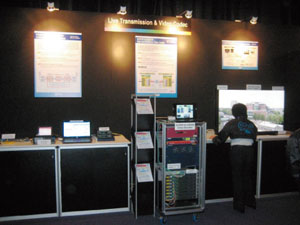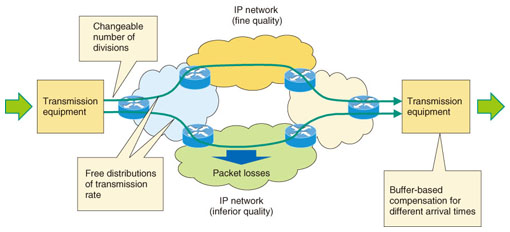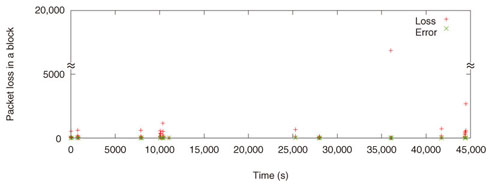1. Video delivery service
Video delivery services such as those enabling public viewing have become popular recently. They are often used to temporarily show theatrical performances, concerts, and sports events in theaters. Video content in such services is often played using storage media such as digital video disks (DVDs). However, a realtime delivery service has attracted much attention in the business world and is becoming the primary service because it offers simultaneous experiences and interactivity.
To operate a service that is commercially successful, it is necessary to achieve stable and secure transmission. In addition, high-speed transmission is required for high-definition video transmission to increase its popularity.
NTT Network Innovation Laboratories has been studying a 4K video, low-latency transmission system. We have developed Internet protocol (IP) packet compensation technology using forward error correction (FEC) that achieves highly reliable IP transmission.
In addition, in the R&D Forum held in February 2011, we demonstrated live IP transmission of 8K video (Super Hi-vision) [1] between Japan and the UK. In this demonstration, we compensated for 500 burst packet losses and confirmed the reliable IP transmission using our developed transmission equipment without depending on codecs. In September 2011, we also demonstrated 8K video IP transmission between the Netherlands and the UK at IBC 2011 (International Broadcast Conference 2011) [2] using an improved FEC function (see Fig. 1).

Fig. 1. Display of 8K video IP transmission at IBC 2011.
2. Highly reliable IP transmission technology
In video delivery, packet losses and jitter that occur in transmission significantly affect the video quality; consequently, functions to suppress them are necessary for the video IP transmission service. We have been studying output packet control to handle several IP streams and have also investigated ways of achieving secure IP transmission. For transmission with greater reliability, we developed highly efficient error correction technology and multipath transmission technology. These technologies are achieved with software that runs on a small personal computer.
2.1 Highly efficient error correction technology
The most effective way to achieve reliable IP transmission is to compensate for packet loss. We have adopted the low-density generator matrix (LDGM) code FEC, which is able to encode large data. The LDGM FEC can theoretically encode and decode at high speed. It is therefore suitable for the large-size of 8K video transmissions.
In previous international IP transmissions of 8K video, as many as 15,000 burst packet losses occurred. We assume these were caused by changing the transmission line. It is important to reduce such packet losses. However, providing a carrier-grade dedicated line is not possible for public viewing of a temporary event, so it is difficult to secure adequate communication quality in global IP networks.
In general, an error correcting code can achieve better error reduction performance if the block length is chosen to be large, but this causes a delay. On the basis of the experimental results, we designed the block length and redundancy to compensate for a burst loss of approximately 15,000 packets. Our well-designed parity matrix enables the compensation performance for burst packet loss to be comparable to that for random packet loss.
2.2 Multipath transmission technology
We implemented a multipath transmission function to enhance the reliability. Multipath transmission is a method to distribute the IP traffic as multiple transmission paths on a network, as shown in Fig. 2.

Fig. 2. Multipath transmission.
For example, when the IP traffic is distributed on two paths having equal quality, the total number of lost packets occurring in multipath transmission may in principle be twice the number that occurs in normal transmission. The transmission rate is half, though, so the number of lost packets caused by the change in the transmission line is reduced to half. In addition, multipath transmission can reduce the network load by lowering the transmission rate. Therefore, it improves transmission reliability by dispersing the risk of packet losses during transmission.
In multipath transmission, when the quality of a network declines, the IP stream can gradually be shifted to a network with better quality to improve the transmission rate. For example, we can select a bandwidth-guaranteed service called the Dynamic Circuit Network (DCN) [3], which served Internet2 and GÉANT, as a candidate for the better quality network.
It is difficult to prepare multiple transmission paths in normal IP transmission, but we can achieve multipath transmission when using multiple access lines simultaneously or using research and education IP networks. The multipath transmission can change the transmission rate freely to each path.
When the transmission bandwidth is inadequate, multipath transmission can secure the required bandwidth by using multiple paths and gathering the IP streams at the reception side. The arrival times of IP streams are different when multipath transmission is used. Therefore, we designed a transmission system that permits 100-ms time differences. We also designed a function to duplicate IP streams. Therefore, if we cannot transmit by IP multicast, this function makes it possible to transmit the same IP stream to multiple places.
3. Experiment
NTT Network Innovation Laboratories conducted an IP transmission experiment of 8K video between the UK and USA and also between the UK and Japan at the Internet2 Member Meeting 2012 (Internet2 meeting), in April 2012. The network and the transmission system in the experiment are shown in Fig. 3. The BBC in London was the transmitting side, and the Internet2 meeting venue in the USA and NHK Science & Technology Research Laboratories (NHK STRL) in Japan were the receiving sides. In the Internet2 meeting demonstration, we applied the FEC technologies and multipath transmission technologies to the 8K video IP transmission.

Fig. 3. Transmission system and network used in experiment.
In the experiments, we utilized international research and education IP networks (JANET, GÉANT2, INTERNET2, SINET, and GEMnet2). The 8K video was transmitted in two IP streams via Internet2 and SINET. Between BBC and NHK STRL, the delay was about 264 ms, and 20 routers were used.
The IP stream rate of 8K video was originally 300 Mbit/s. We added 20% redundancy with FEC at the transmission equipment, so the total IP stream rate was 360 Mbit/s. The block length was set to 150,000. The total delay was approximately 14 s, which was based on FEC using such a large block length.
The state of packet loss occurrence via Internet2 is plotted in Fig. 4. In the measurements at approximately 12 hours, packet loss did not occur most of the time. However, a burst loss of 17,246 packets occurred once, and packet losses of fewer than 1000 packets occurred about 20 times. In the experiments, the transmission system was able to compensate for all the packet losses including the burst loss of 17,246 packets.

Fig. 4. State of packet loss occurrence via Internet2.
In the multipath transmission, we examined the use of two paths via Internet2 and SINET. The FEC setting was the same as in the normal transmission. The difference in network delay between two paths was only 7 ms, but in 6-day experiments, we observed a 414-ms delay via Internet2 and a 370-ms delay via SINET. Through the experiments, we confirmed that the multipath transmission was equivalent to normal transmission. We also verified the expected transmission results when the ratio of transmission via Internet2 and SINET was set to 80:20 and 20:80.
References
| [1] | Y. Nojiri, K. Iguchi, K. Noguchi, T. Fujii, and M. Ogawara, "Super Hi-vision International Transmission Experiment Using Global Research and Education IP Network," Broadcast Technology Vol. 64, No. 6, pp. 135¡Ý141, 2011 (in Japanese).
|
|---|
| [2] | S. Sakaida, K. Iguchi, N. Kimura, M. Ogawara, and T. Fujii, "Super Hi-vision International Transmission Experiment and Exhibit of Those Apparatus in IBC2011," Broadcast Technology, Vol. 65, No. 1, pp. 151¡Ý156, 2012 (in Japanese).
|
|---|
| [3] | Dynamic Circuit Network.
http://www.internet2.edu/network/dc |
|---|
 |
- Masanori Ogawara
- Senior Research Engineer, NTT Network Innovation Laboratories.
He received the B.E. and M.E. degrees in electrical engineering from Keio University, Kanagawa, in 1992 and 1994, respectively. In 1994, he joined NTT Network Service Systems Laboratories, where he studied optical switching systems before moving to NTT COMWARE. He is currently researching high-definition video transmission systems in NTT Network Innovation Laboratories. He is a member of the Institute of Electronics, Information and Communication Engineers (IEICE). He received the IEICE Best Paper Award in 1999.
|
|---|
 |
- Naohiro Kimura
- Research Engineer, NTT Network Innovation Laboratories.
He received the B.E. and M.E. degrees in mechanical engineering from the University of Tokyo in 1991 and 1993, respectively. He joined NTT in 1993. His current research interests include developing a reliable IP transmission system.
|
|---|
 |
- Tatsuya Fujii
- Group Leader of Media Processing Systems Research Group, NTT Network Innovation Laboratories.
He received the B.S., M.S., and Ph.D. degrees in electrical engineering from the University of Tokyo in 1986, 1988, and 1991, respectively. He joined NTT in 1991. He has been researching parallel image processing and image communication networks. In 1996, he was a visiting researcher at Washington University in St. Louis, USA. He is a member of IEICE, the Institute of Image Information and Television Engineers, and IEEE.
|
|---|
















